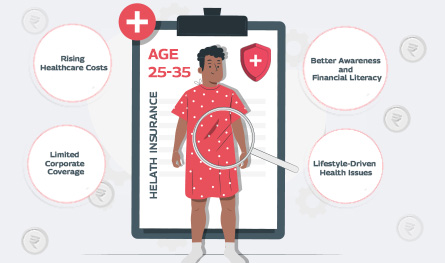Related Articles
 Jan 08, 2025
Jan 08, 2025
Is Varicose Vein surgery covered under the health insurance policy in India
 Health Insurance
Health Insurance
.png)
CIS or customer information sheet is a document that summarizes and gives you a glance into the key details of a health insurance policy. As per an announcement of the IRDAI or the Insurance Regulatory and Development Authority of India, from 1 January 2024, insurance companies are required to revise the CIS to highlight policy details in simple words to make it easy for policyholders to understand and comprehend the health insurance jargon well.
.png)
Thus, the revised CIS will highlight the policy details of health insurance policy including sub-limits, waiting period, exclusions, NCB, free-look period, portability, etc., in simple terms for clarity of the policyholder. The CIS will also offer guidance on the claim submission procedure, including contact details for complaints, turn-around time (TAT) for settling claims, and more in the policyholder’s chosen language.
A CIS (Customer Information Sheet) is a document that summarizes the essential details of a health insurance policy, allowing policyholders to understand the key features of their coverage. It includes information such as the sum insured, premiums, coverage details, exclusions, and more.
As per the latest announcement by the IRDAI (Insurance Regulatory and Development Authority of India), starting January 1, 2025, the format of the CIS will be revised. This update aims to make health insurance policies easier for policyholders to understand by simplifying complex terminology. The new format will help customers make more informed decisions when purchasing or renewing health insurance policies, ensuring they fully understand their coverage and benefits.
The new Customer Information Sheet (CIS) for health insurance plans, effective from January 2025, brings several changes designed to make it simpler for policyholders to understand their health insurance policies. Here’s how it differs from the previous versions:
The primary change in the new CIS is the use of simpler, easier-to-understand language. The previous CIS was often filled with complex insurance terminology, which could confuse policyholders. The updated version aims to eliminate jargon and use plain language so that all policyholders, regardless of their knowledge of insurance terms, can easily comprehend the details.
The new CIS will include a clearer breakdown of the benefits offered by the policy. It will be more transparent, showing not only the benefits but also the limitations and exclusions in a way that is easier to read and understand. This will help customers know exactly what is covered and what isn’t.
The new CIS will follow a standardized format across all health insurance providers. This means that no matter which insurer you choose, the key information will be presented in a consistent way, making it easier to compare policies from different providers.
The new CIS will now also include additional important information such as:
The overall goal of the new CIS is to improve customer understanding. By focusing on providing essential information clearly and concisely, the revised CIS aims to make health insurance more accessible to everyone.
With the new format, customers will have more transparent access to terms like exclusions, sub-limits, co-payment clauses, and no-claim bonuses, allowing them to make more informed decisions when purchasing or renewing health insurance.
The fact that policy documents of health insurance policies are lengthy and are filled with jargon or complex words makes them difficult to comprehend. This way, many policyholders miss out on important information about the policy. However, the updated CIS acts as a quick guide for the policyholders to understand crucial terms with ease. With the introduction of the new CIS or customer information sheet, the issue of decoding complex meanings of their coverage will become easy for the policyholders.
You may note that a normal policy document of a health insurance policy has more than 10,000 words written on it about the policy. Reading the entire policy document takes a regular reader around one hour and 15 minutes. Not only that, but the reading comprehension of the policy document is so low that even an English-speaking adult may find it difficult to understand.
The revised CIS will likely make it mandatory for insurers to offer the policy details in clear and concise language that is easy to understand for novice policyholders.

Paybima Team
Paybima is an Indian insurance aggregator on a mission to make insurance simple for people. Paybima is the Digital arm of the already established and trusted Mahindra Insurance Brokers Ltd., a reputed name in the insurance broking industry with 17 years of experience. Paybima promises you the easy-to-access online platform to buy insurance policies, and also extend their unrelented assistance with all your policy related queries and services.
.png)
When you're planning to take a personal loan, knowing your monthly EMI in advance can help you stay financially prepared. The Muthoot Personal Loan EMI Calculator is a simple and efficient tool that provides instant EMI estimates based on your loan amount, interest rate, and tenure.


Relocating your two-wheeler to a different state needs to follow many procedures. Depending on the duration for which you are moving to the new place, it becomes necessary to transfer your vehicle papers if it is for more than a year. Although tedious, the process of relocating vehicles can become easy if you follow certain tips mentioned in this post. Read on!


In what’s being called a quiet healthcare revolution, India’s young working professionals are reportedly making the most health insurance claims – outpacing even senior citizens. Surprised? So are the insurance providers. Young adults ranging between 25 and 35 years, who are often assumed to be in peak health, are now dominating the charts in health insurance claims by age.


If you think lifestyle-related health issues only show up after 40, think again. Youth no longer guarantees immunity. Today’s 25 - 35 age group is increasingly facing medical issues that only plague older adults. The reason? Long working hours at the desk, deliveries on speed dial, and a social life that rarely includes a decent amount of sleep are some of the reasons for the early onset of medical conditions like diabetes, anxiety, and hypertension.
